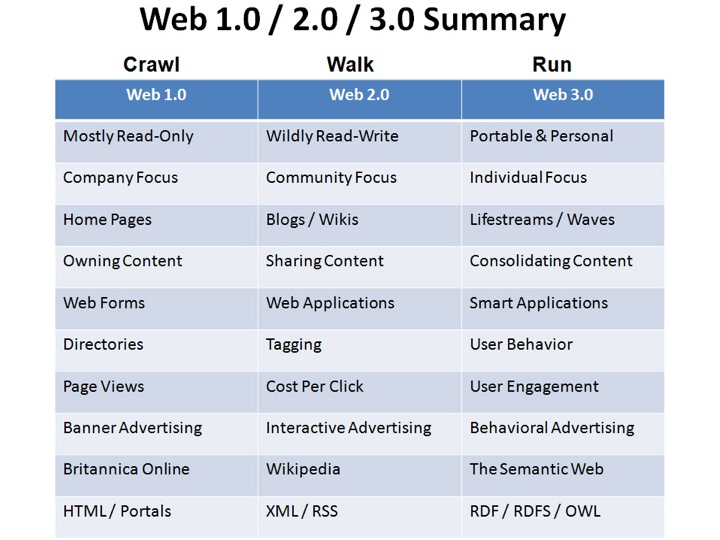A2 – Media in the Online Age

We’ve spent some time discussing the development of the web, from the days of Tim Berners-Lee to the present day and beyond. We’ve outlined what Gauntlet wrote about Web 2.0 and interactivity but we haven’t looked at the differences 2.0 has with Web 3.0. This should help clarify that.
Following from: https://lifeboat.com/ex/web.3.0:
Web 1.0. Web 1.0 was the first generation of the Web. During this phase the focus was primarily on building the Web, making it accessible, and commercializing it for the first time. Key areas of interest centered on protocols such as HTTP, open standard markup languages such as HTML and XML, Internet access through ISPs, the first Web browsers, Web development platforms and tools, Web-centric software languages such as Java and Javascript, the creation of Web sites, the commercialization of the Web and Web business models, and the growth of key portals on the Web.
Web 2.0. According to the Wikipedia, “Web 2.0, a phrase coined by O’Reilly Media in 2004, refers to a supposed second generation of Internet-based services — such as social networking sites, wikis, communication tools, and folksonomies — that emphasize online collaboration and sharing among users.”
I would also add to this definition another trend that has been a major factor in Web 2.0 — the emergence of the mobile Internet and mobile devices (including camera phones) as a major new platform driving the adoption and growth of the Web, particularly outside of the United States.
 Web 3.0. Using the same pattern as the above Wikipedia definition, Web 3.0 could be defined as: “Web 3.0, a phrase coined by John Markoff of the New York Times in 2006, refers to a supposed third generation of Internet-based services that collectively comprise what might be called ‘the intelligent Web’ — such as those using semantic web, microformats, natural language search, data-mining, machine learning, recommendation agents, and artificial intelligence technologies — which emphasize machine-facilitated understanding of information in order to provide a more productive and intuitive user experience.”
Web 3.0. Using the same pattern as the above Wikipedia definition, Web 3.0 could be defined as: “Web 3.0, a phrase coined by John Markoff of the New York Times in 2006, refers to a supposed third generation of Internet-based services that collectively comprise what might be called ‘the intelligent Web’ — such as those using semantic web, microformats, natural language search, data-mining, machine learning, recommendation agents, and artificial intelligence technologies — which emphasize machine-facilitated understanding of information in order to provide a more productive and intuitive user experience.”
The Semantic Web
 Web 3.0 is connected to the idea of the ‘Semantic Web’. This term was coined by Tim Berners-Lee to represent:
Web 3.0 is connected to the idea of the ‘Semantic Web’. This term was coined by Tim Berners-Lee to represent:
I have a dream for the Web [in which computers] become capable of analyzing all the data on the Web – the content, links, and transactions between people and computers. A “Semantic Web”, which makes this possible, has yet to emerge, but when it does, the day-to-day mechanisms of trade, bureaucracy and our daily lives will be handled by machines talking to machines. The “intelligent agents” people have touted for ages will finally materialize.
“Semantic Web” is sometimes used as a synonym for “Web 3.0”, though the definition of each term varies.

So, maybe the web is more than just cat gifs. Maybe. Maybe not.







